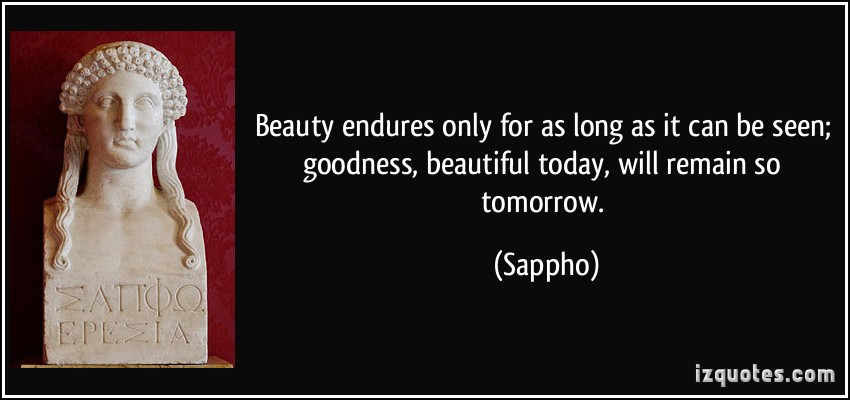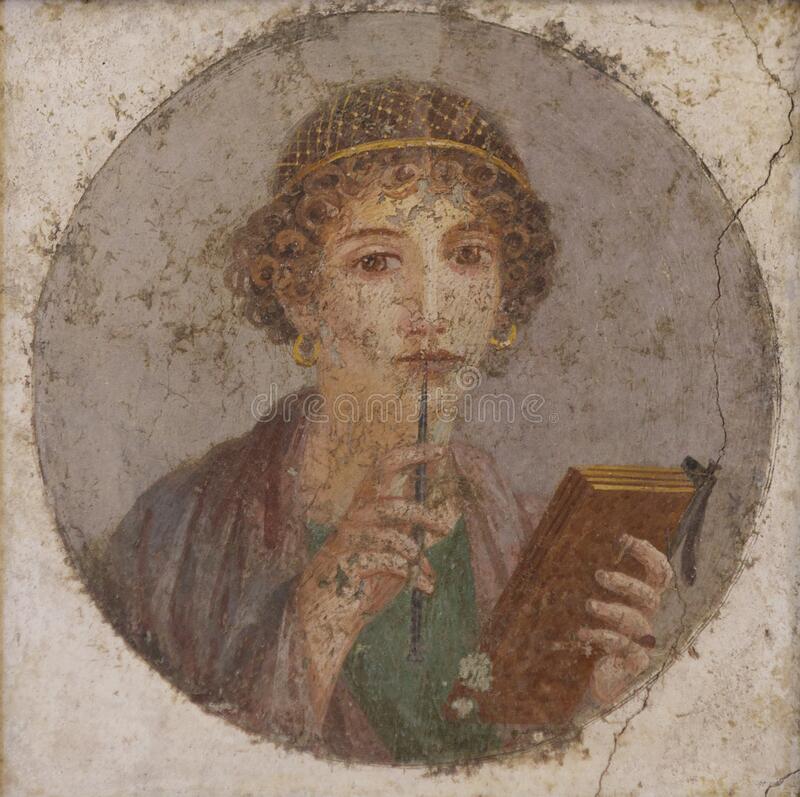Sappho, an Archaic Greek poet, was considered one of the greatest poets of her time. She lived on the island of Lesbos at the end of the seventh and beginning of the sixth centuries BC. In ancient times, Sappho was widely regarded as one of the greatest lyric poets and was referred to as the “Tenth Muse” and “The Poetess”.
Sappho was regarded as highly as Homer, the greatest poet in history, for the invention of lyric poetry. She composed nine volumes of poetry out of which only one full poem survives. The rest are just fragments. Although the majority of Sappho’s works is lost in the whirlpool of time, the few that survived are incredible and poignant.
Life of Sappho
Not much information is found about Sappho’s life. She hailed from a wealthy family from Lesbos. According to ancient sources, she had three brothers: Charaxos (Χάραξος), Larichos (Λάριχος), and Eurygios (Εὐρύγιος). Her parents’ names are still unknown. She grew up in Lesbos, where she led a highly esteemed life. She learned the lyre and composed poetry and music.
Some sources mention that she was exiled to Sicily around 600 BC for her political views, where she may have continued working until around 570 BC. According to a myth, she committed suicide by leaping from the Leucadian cliffs for her lover, the ferryman Phaon. Some sources also mention the possibility that she may even have had a daughter named Cleis.
Sappho’s Illustrious Journey as a Poet
In the modern day, Sappho is often regarded as a lesbian poet, although there’s no evidence can be found to solidify the fact. Her sexual preference should not hold much importance as her work is the legacy the world looks forward to.
Sappho’s poems are woven brilliantly with intimate human emotions, which resonate with even modern-day readers. She invented the Sapphic meter or Sapphic stanza consisting of three lines of eleven beats and a concluding line of five.
Sappho was celebrated for her genius poetic works in her own time and long afterward. The geographer and historian Strabo who lived between 63BCE-23CE remarked in his book, Geography:
“And along with these flourished also Sappho, a marvelous woman; for in all the time of which we have the record
I do not know of the appearance of any woman who could rival Sappho, even in a slight degree, in the matter of poetry.”

Her Poetic Style
Sappho’s impressive poetic style is what makes her so remarkable. Her lyrical language is enriched with elements from Aeolic vernacular speech and Aeolic poetic tradition with dashes of epic Homeric vocabulary. Her poems and songs were woven with concise and picturesque phrases. She was known for her ability to stand in a distance and judge her ecstasies and grief in her works.
Sappho used floral and imageries related to nature to depict youth and feminine beauty. In many of her poems, she used images of garlands, scents, and apples to describe feminine sexuality. She mainly explored a world of beauty, caresses, whispers, and desires, hymns sung for the goddess Aphrodite and tales of mythical love.
Fragment 16, considered her most sublime poem, illustrates beauty as the adage of the philosopher, Protagoras — “man is the measure of all things”:
Some say a host of cavalry, others of infantry,
and others of ships, is the most beautiful
thing on the dark earth, but I say it is
whatever a person loves.
It is perfectly easy to make this
understood by everyone: for she who far
surpassed mankind in beauty,
Helen, left her most noble husband
and went sailing off to Troy with no thought at all
for her child or dear parents,
but [love?] led her astray …
lightly …
[and she]
has reminded me
now of Anactoria
who is not here;
I would rather see her
lovely walk and the bright sparkle of her
face than the Lydians’ chariots and armed
infantry …
Appreciation of Sappho’s Works in the Modern Age
Even with time, the extraordinariness of Sappho’s poetry has not faded. Modern critics are also appreciative of the distinctive charm of the poetry of Sappho. In the 9th century, Boccaccio’s referred to her as a talented woman in “De Claris Mulieribus”. Another work “City of Ladies” by Christine de Pisan mentions her as a learned lady.
While most of Sappho’s works were lost in time, the Sapphic stanza continued to be a part of medieval lyric poetry. Her poetry began to influence European poetry when her works were rediscovered during the Renaissance period.
In the 16th century, La Pléiade, a group of French poets, experimented with Sapphic stanzas to write love poems in the first person female perspective.
Sappho and her works were great inspirations for early modern and modern composers. Sappho (1794) by Jean-Paul-Égide Martini, Sappho (1963) by Peggy Glanville-Hicks, Sappho (1897) by Jules Massenet, the striking piece Psappha (1975) and orchestral work Aïs (1980) by Iannis Xenakis, and the composition Charaxos, Eos and Tithonos (2014) by Theodore Antoniou are some of the significant works of these modern composers based on Sappho’s life and works.
One of her poems “Ode to Aphrodite” has been considered an influential piece in the development of lyric poetry during the Romantic era of literature. Nineteenth-century renowned poet Alfred Lord Tennyson’s poems “Eleanore” and “Fatima” were based on Sappho’s fragment 31.
The Imagists of the twentieth century such as Ezra Pound, Hilda Doolittle, and Richard Aldington were also influenced by the fragments written by Sappho. Pound’s poems in his early collection Lustra were adaptations of Sapphic poems. Hilda Doolittle’s poetry often reverberated the style, theme, and content of Sapphic poetry.
In recent years, more and more works of Sappho are being discovered. We’ll have a more in-depth insight into her works in another post.

